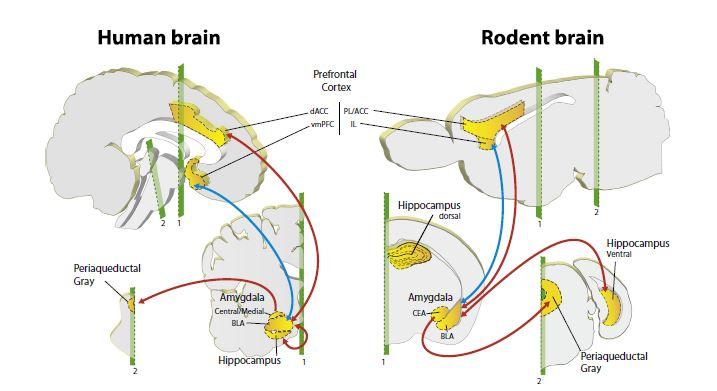Neuronal Circuits for Fear Expression and Recovery: Recent Advances and Potential Therapeutic Strategies
 |
In this publication in Biological Psychiatry, Cyril Dejean and Cyril Herry review the functional role of distinct neuronal structures involved in the expression and recovery of conditioned fear responses and detail the non-canonical neuronal circuits recently identified to play a key role in fear expression. The identification of neuronal circuits dedicated to fear expression may promote the development of new therapeutical strategies for anxiety disorders and related psychiatric conditions.
 |
 |
Neuronal circuits for fear expression and recovery: recent advances and potential therapeutic strategies
Over the past decades, there has been a tremendous interest in understanding the circuit mechanisms governing fear behavior in particular due to clinical reasons. Indeed, anxiety-related disorders represent the most prevalent lifetime psychiatric conditions and despite efficient therapeutic strategies, relapse of anxiety-related behavior occurs in most of the cases. In this review we provide an update of our current knowledge of the neuronal circuits mediating conditioned fear expression and recovery in rodents with a particular focus on the newly identified neuronal circuits involved during freezing behavior with unprecedented technological approaches. First, we review the functional role of distinct neuronal structures in the expression and recovery of conditioned fear responses based on imaging studies in humans and lesion and inactivation studies in rodents. In a second step, we review in detail the non-canonical neuronal circuits recently identified to play a key role in fear expression and recovery. In particular, recently collected data have refined our understanding of the local circuitry and mechanisms involved at the level of the amygdala, prefrontal cortex, hippocampus and brainstem, in the regulation of conditioned fear expression and recovery. Novel circuits composed of specific cell populations such as specific classes of inhibitory interneurons have been identified and proven to be critical for the control of fear expression. These studies have demonstrated that the manipulation of small subsets of excitatory or inhibitory neurons is often sufficient to reduce or enhance fear expression, which provides novel therapeutic avenues for anxiety disorders. Finally, we discuss how the identification of neuronal circuits dedicated to fear expression may promote the development of new therapeutical strategies for anxiety disorders and related psychiatric conditions.
Abstract
Recent technological developments, such as single unit recordings coupled to optogenetic approaches, have provided unprecedented knowledge about the precise neuronal circuits contributing to the expression and recovery of conditioned fear behavior. These data have provided an understanding of the contributions of distinct brain regions such as the amygdala, prefrontal cortex, hippocampus, and periaqueductal gray matter to the control of conditioned fear behavior. Notably, the precise manipulation and identification of specific cell types by optogenetic techniques have provided novel avenues to establish causal links between changes in neuronal activity that develop in dedicated neuronal structures and the short and long-lasting expression of conditioned fear memories. In this review, we provide an update on the key neuronal circuits and cell types mediating conditioned fear expression and recovery and how these new discoveries might refine therapeutic approaches for psychiatric conditions such as anxiety disorders and posttraumatic stress disorder.
Authors : Dejean C, Courtin J, Rozeske RR, Bonnet MC, Dousset V, Michelet T, Herry C
Biol Psychiatry. 2015 Mar 24. pii: S0006-3223(15)00255-3. doi: 10.1016/j.biopsych.2015.03.017. [Epub ahead of print]
KEYWORDS:
Amygdala; Anxiety disorders; Fear expression; Neuronal circuits; Prefrontal cortex; Single unit recordings

